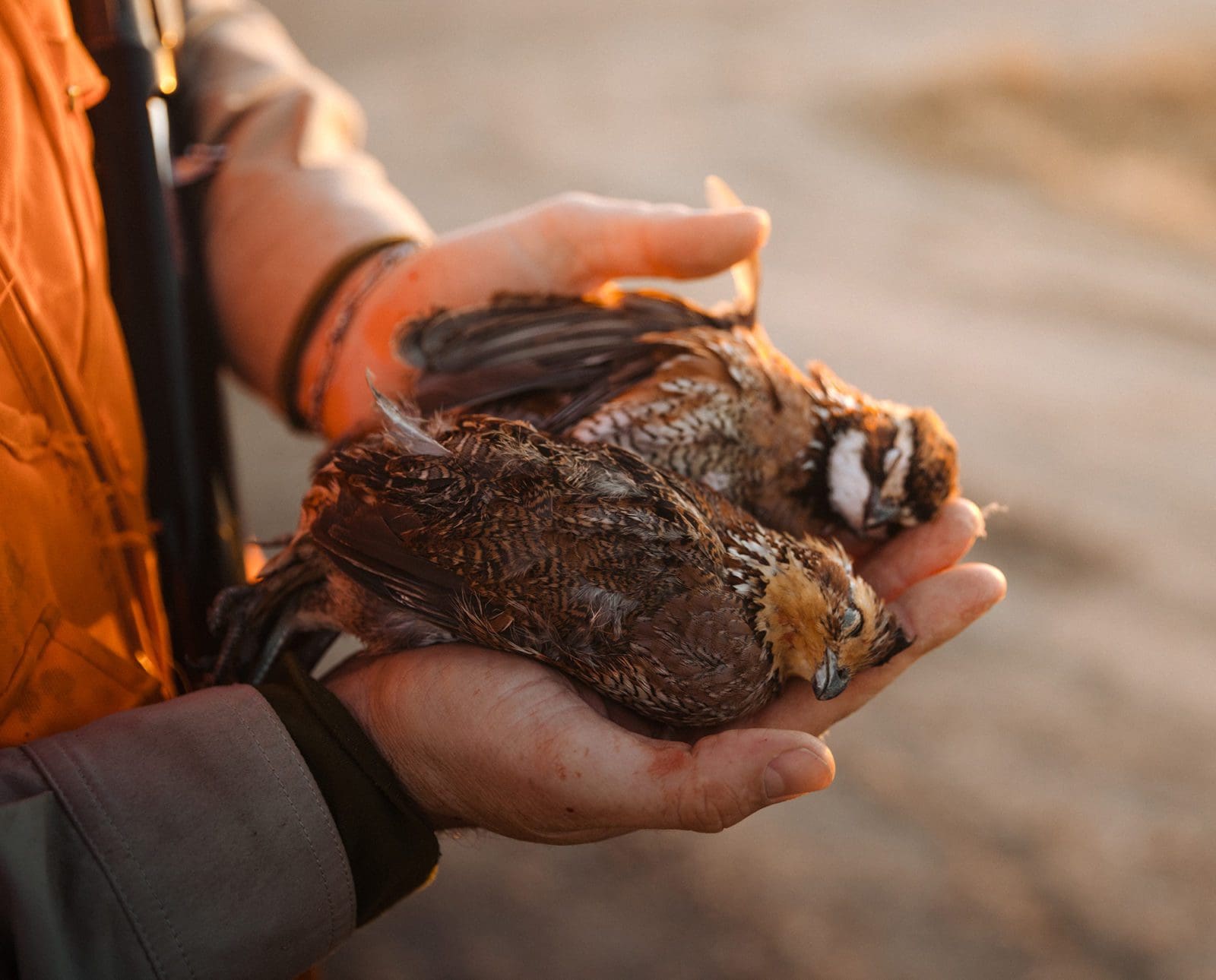Home » Hunting Culture » How to Secure the ‘Unofficial Kansas Grand Slam’
How to Secure the ‘Unofficial Kansas Grand Slam’

Edgar Castillo is a recently retired law enforcement officer for…
Kansas hosts more upland birds worth hunting than just the major species; learn where to find them to secure an unofficial grand slam
Bird hunters: click your leather boot heels together and utter that famous movie phrase: “There’s no place like home.”
Glenda the Good Witch may then whisk you away to that far away Land of Oz: Kansas, an enchanted land full of upland bird hunting opportunities for the not-so discriminating wingshooter, and more importantly the chance to complete the “unofficial” Kansas upland grand slam.
Kansas is a big place—a lot bigger than you might think. Highways and backroads divide fields of milo and corn, as well as rolling hills and prairie. The state features several distinct regions that offer different habitat communities, each providing an array of mixed bag opportunities. Because of this, the the state boasts some of the best upland bird hunting in the nation. Yes, Kansas is well-known for its pheasant and bobwhite quail numbers, but there is more to the state than raucous roosters and fast-flying bobwhites. Yes, even the greater prairie-chicken is somewhat well-known to bird hunters, as only a handful of states offer the chance to hunt the iconic prairie bird. Interestingly, more prairie chickens are hunted during the early September through October season than during the normal upland season.
Yet, these other birds that I am talking about are scattered about the state, each within their own niche of specific habitat and landscape. Finding them, however, can be a bit more difficult and thus requires a little more research, scouting, and walking.
Birds in the ‘unofficial Kansas grand slam’
So what are the other birds? To start: scaled quail. It is not widely known that Kansas has a small huntable population of scaled quail in the extreme southwest corner. Finding them is difficult, but worthwhile. It gives the bird hunter the feeling of hunting in the southwest states of Arizona and New Mexico, to a lesser degree, of course.
Another bird not well known by Kansas bird hunters is the underrated snipe. These little odd-looking birds are found mostly in marshes, bogs, and other damp habitats, and while we’re talking about long-beaked birds, let’s throw in the far more well-known cousin to the snipe, the American Woodcock. Yes, there are woodcock in Kansas. Most are taken while hunting bobwhite quail along the Kansas and Missouri border in the far eastern part of the state.
The last bird to be added to the grand slam list is the dove. Kansas, in the last couple of years, has extended its dove season well into the regular upland bird season giving hunters the chance to shoot the birds when they flush from grain and crop fields as well as when they’re perched in trees.
Each bird gives hunters in Kansas a chance to broaden their upland bird horizons. Some, such as the dove, may not be as glamorous to hunt during the regular upland bird season, but those who are not too picky still get a rush of wingbeats when flushed.
The seven game birds that make up the “unofficial” Kansas upland bird grand slam are spread out across the state and are accessible on state- and publicly-accessed lands with some work and boot leather. Most of Kansas is privately owned, but the state still has plenty of public access to take advantage of.
Land breakdown to secure the ‘unofficial Kansas grand slam’
State public lands
Kansas has over 300,000 acres of public land accessible to hunters. Most of these lands are in the form of Wildlife Management Areas (WMA). Also included are federal lands that include National Wildlife Refuges, operated by the U.S. Fish and Wildlife Service (USFS), and the Cimarron National Grasslands.
Private property with public access
Started in 1995, the program best known as Walk-In Hunting Access (WIHA) was intended to enhance the strong Kansas hunting heritage and tradition by providing hunting access to private property.
The program is one of the most successful access programs in the country and has been used as a model by several states. Through WIHA, the state leases private land for public hunting access and currently has over 1 million acres enrolled and open to hunting. Tracts range in size from 40 acres up into the thousands.
Species and ranges checklist to secure the ‘unofficial Kansas grand slam’
The ring-necked pheasant rooster has become such a fixture across the Kansas landscape that it is synonymous when it comes to bird hunters visiting the state. The annual pheasant harvest ranks among the top four in the nation.
Generally, the best pheasant hunting is typically in the north and southwest, with the north-central part being the most stable in pheasant numbers. Other areas of the state offer good pheasant hunting opportunities, with the southeast area the least likely for a hunter to encounter any ring-necks.
Hunters may only shoot four cockbirds.
The bobwhite quail population has exploded in the past few years. Populations are traditionally best in the eastern third of the state, but the numbers have increased throughout the state.
Hunters going after bobwhites will encounter them in the Red Hills of the southwest, as well as up and down the central and north-central corridor and the often overlooked northeastern corner. Many of these areas will sustain a very good bobwhite/pheasant combination.
Hunters may only shoot eight bobwhite quail. This is as a single species or in combination with scaled quail.
Dove, as noted, have an extended season well into the late months in Kansas. Doves are found throughout the state in overworked crop fields, watering holes, and grassland ponds.
Although many migrate south, on occasion, flocks of doves can be found and hunted alongside other upland game birds. Both Eurasian and white-winged doves, which are designated as invasive species, are found throughout the state, which adds to the opportunity.
The daily bag limit for dove is 15, while the possession limit is 45. The daily bag limit of 15 applies to mourning and white-winged doves, single species or in combination. There is no limit on Eurasian or ringed turtle doves, but any taken in addition to the mourning and white-winged dove daily bag must have a fully-feathered wing attached while being transported.
Snipe are considered more of an incidental prize. This mottled brown game bird can be found in fresh marshes, muddy banks of rivers and ponds, wet pastures, flooded agricultural fields, and of course wetlands and bogs. The best snipe hunting is found within Cheyenne Bottoms and Quivira National Wildlife Refuge.
The daily limit for snipe is set at eight, while the possession limit is 24.
Greater prairie-chickens are found in grasslands, like the mid- and tall-grass prairies of the Flint and Smoky Hills. Their range extends from the central portion of the state up towards the north-central sections and northwest corner.
There is a limit of two chickens per hunter.
Scaled quail is the second quail species found in Kansas. They are found in the extreme southwest corner of the state with the highest concentration located within the 108,000 acres of the Cimarron National Grasslands. Scaled quail numbers are very dependent on the amount of rainfall, and populations go up and down with the advent of water or lack thereof. Hunters should work the arid prairie, concentrating bird dogs in the shortgrass and sagebrush flats of the grasslands and structures such as farm implemented trash piles.
Hunters can shoot a limit of eight, either as a single species or combined with bobwhites.
Woodcock, like snipe, are short-legged, large-bodied, and long-beaked birds. Woodcock are less abundant than snipe in Kansas. Woodcock occur in more wooded or shrubby habitats than snipe and are concentrated along riparian areas. This specific habitat preference substantially reduces their distribution in the far eastern side of Kansas.
A good place to start for interested hunters is the Marais des Cygnes WMA and National Wildlife Refuge. Few Kansas bird hunters make woodcock their primary target, but there is a daily limit of three birds and possession limit of nine.
Preparing Kansas’ upland birds for delicious meals
The best part of the ‘unofficial Kansas grand slam’ is that every bird provides a different flavor profile, and with that many opportunities for recipes.
Whether you want to experiment with pheasant in Asian or Mexican dishes, whip up a batch of jalapeño poppers, or play outside the traditional boundaries with fully plucked quail, be sure to honor the Jayhawk State’s birds by treating them right after the kill.
Edgar Castillo is a recently retired law enforcement officer for a large Kansas City metropolitan agency. He also served in the United States Marine Corps for twelve years. Edgar longs for the colors of autumn and frosty, winter days so he can explore the landscapes in search of wild birds in wild places. His passion lies in the uplands as he self-documents his travels across public lands throughout Kansas hunting open fields, walking treelines, & bustin’ through plum thickets.



